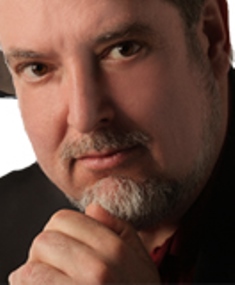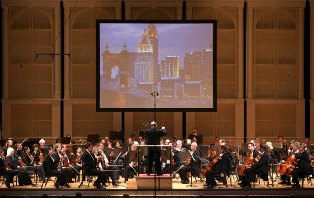
CSO Season Ends with Fanfare
Friday night’s Cincinnati Symphony concert at Music Hall was
about mastery and celebration.

Blinding mastery in the case of Samuel Barber’s Piano Concerto, performed by Garrick Ohlsson. Also, the mastery of the CSO in Aaron Copland’s Symphony No. 3, led by guest conductor Robert Spano.
Theme of the concert was “Fanfare,” in reference to Copland’s “Fanfare for the Common Man,” commissioned and premiered by the CSO in 1943 and used by Copland in his Symphony No. 3. It was the final concert of the CSO’s 2012-13 Music Hall season.
It was more than just a concert, however. It was an event, with pre and post-concert activities in Over-the-Rhine and Washington Park -- including a pre-concert bike ride through OTR -- and the CSO premiere of “All Things Majestic” by composer/CSO creative director Jennifer Higdon in honor of Cincinnati’s 225th birthday.
Ohlsson commanded, indeed inhabited, the Barber Concerto, a work calling for the highest virtuosity, from the quicksilver Allegro appassionato through the rhythmically charged Allegro molto finale. There seemed nothing Ohlsson could not do at the keyboard, whether addressing it swiftly top to bottom, or delineating cleanly-etched, silvery tones in between. The second movement (Canzone) was exquisite for its sensitivity and grace, drawing a collective sigh from the audience. Rapport with Spano and the CSO was close throughout, and the work’s thrilling conclusion was met with a hearty ovation. Ohlsson obliged with an encore, Charles Tomlinson Griffes’ gentle, impressionistic “The White Peacock.”
Higdon wrote “All Things Majestic” on commission from the
Grand Teton Music Festival in 2011. Its four movements were conceived to
reflect the majesty of Grand Teton National Park. The 2011 premiere was
accompanied by images of Grand Teton National Park taken by a group of nature
and park photographers. For the CSO
premiere, CET gathered photos of Cincinnati from the community and prepared a video
presentation projected onto a screen above the stage. It is a testament to music
and what it can summon in the listener that Higdon could re-name and apply
those same four movements to the city of Cincinnati. Thus “Teton Range” became “A
Majestic Skyline,” “String Lake” became “Neighborhoods and Nature,” “Snake
River” became “The River Runs By It” and “Cathedral” became “Iconography of a
Great American City.” It worked -- perhaps too well, for one had to close his
or her eyes now and then to concentrate on the music, with the constant stream
of images fading in and out on the screen.

The brassy first movement took in the Cincinnati skyline, fireworks and all, with a quick, bright run-up to the end. The second movement, for muted strings (reference “String Lake”) was soft and enveloping, with lots of first-desk solos. The third (“The River Runs By It”) was all fun and games, with perky winds, brass and percussion, building to a raucous climax and a final tumble-down of winds. For “Iconography of a Great City,” the music was statuesque to match, with moments of soft reflection. The final image was of a rainbow over the city.
Premiered by the Boston Symphony in 1946, Copland’s Third Symphony, like his American tone poems, evokes the spirit and energy of America. Spano worked hand-in-glove with the CSO to capture all of that in their performance together. The first movement, with its soft beginning and open sonorities, conjured wide open spaces. The second movement, which featured exceptional playing by all sections of the orchestra, was muscular and vigorous. The slow movement, beginning ticklishly high and vibrato-less in the first violins, was by turns plaintive and playful a la Copland’s “Appalachian Spring,” ending in a gentle “amen” by the violas.
The finale, which followed without a break, opened with the fanfare theme in the woodwinds, who handed it off to the brass and percussion for extensive, full-bore treatment. The movement proceeded pell mell through a buildup that crashed into a big dissonant chord, succeeded by keening, piccolo-tinged winds. With the return of the fanfare, the ending was big -- the kind of “big” Music Hall was built for, and brought the crowd to their feet.
In sum, it was a performance that shook Music Hall, literally and figuratively.
The concert repeats at 8 p.m. tonight at Music Hall. Tickets begin at $10, available by calling (513) 381-3300 or order online at www.cincinnatisymphony.org